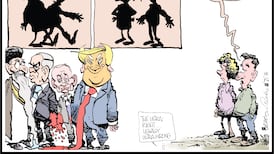DRIVEN BY the government's need to borrow money, high international rates and even higher rates for the punt, interest rates were hitting new highs in 1981 with the mortgage rate heading for 18 per cent. – JOE JOYCE
THE MAIN Irish banks are likely to ask the Central Bank to sanction an interest rate increase of about 2% when they meet tomorrow morning. If an increase is sanctioned, the building societies will follow swiftly with a mortgage rate increase, a society chief warned last night.
A 2% increase would bring the personal overdraft rate to a record 20¼%, while 5- to 7-year term loans for personal borrowers would rise to 22%. A similar building society rate increase would push the ordinary mortgage rate up to 18¼%.
This would mean that the holder of a new average mortgage of £19,000 for 20 years would have seen repayments rise by some £70 a month in the space of just four months. The main banks believe there is a case for a 2½% rise in interest rates, but last night appeared set to settle for 2% when they put their case to the Central Bank.
The rapid rise in Dublin money market rates over the past month has resulted in a severe loss of bank liquidity for the “Big Four” associated banks, and a senior banker last night claimed that the situation had become critical.
When a differential between money market rates and bank interest rates emerges, large companies tend to take advantage of it by drawing down overdraft facilities from the banks and placing the funds into the money market. This time, bankers say, these companies have reacted far more quickly to the opportunity, and many more than usual have taken advantage of it.
Bankers stress that a swift decision from the Central Bank is essential. But the regulatory body may attempt to delay the increase. The Bank might have reason to believe, for example, that additional funds will come into the Dublin money market, bringing rates down from their current all-time peaks.
The building societies, which took only four days to respond to the last bank rates increases, say that they may be forced to respond in a similar swift manner this time. Although there has been an improvement in the inflow of savings into the societies in September following a disastrous three months, demand for loans is still exceptionally high.
An indication of the strain on funds now being experienced by the banks was the organisation of a cartel on the Dublin money market over the past two days.
Sources indicate that the easing of rates in the market yesterday was the result of collaboration between some of the larger takers of deposits (i.e. the main banks) to lower rates throughout the market. There has been no increase in liquidity, bankers state, and it would appear that by consistently quoting rates below those offered by smaller institutions the banks have been partly successful in forcing larger depositors to settle for those lower rates.
http://url.ie/7mp5








